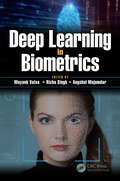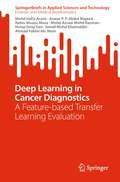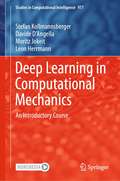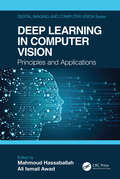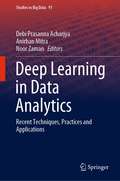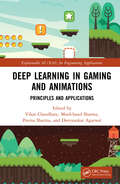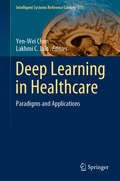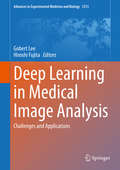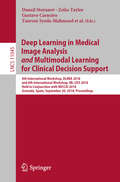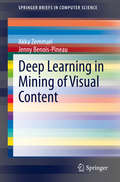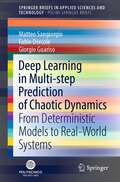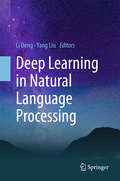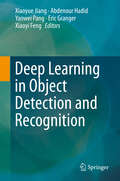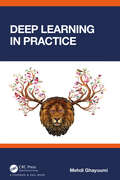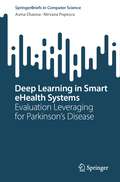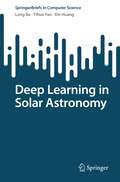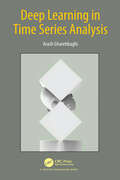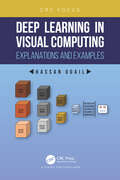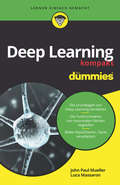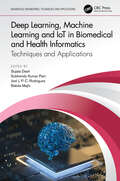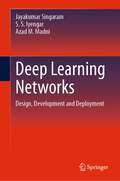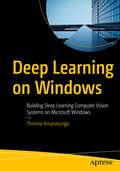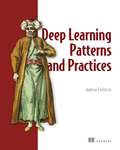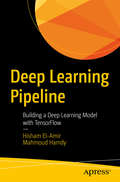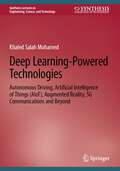- Table View
- List View
Deep Learning in Biometrics
by Richa Singh Mayank Vatsa Angshul MajumdarDeep Learning is now synonymous with applied machine learning. Many technology giants (e.g. Google, Microsoft, Apple, IBM) as well as start-ups are focusing on deep learning-based techniques for data analytics and artificial intelligence. This technology applies quite strongly to biometrics. This book covers topics in deep learning, namely convolutional neural networks, deep belief network and stacked autoencoders. The focus is also on the application of these techniques to various biometric modalities: face, iris, palmprint, and fingerprints, while examining the future trends in deep learning and biometric research. Contains chapters written by authors who are leading researchers in biometrics. Presents a comprehensive overview on the internal mechanisms of deep learning. Discusses the latest developments in biometric research. Examines future trends in deep learning and biometric research. Provides extensive references at the end of each chapter to enhance further study.
Deep Learning in Cancer Diagnostics: A Feature-based Transfer Learning Evaluation (SpringerBriefs in Applied Sciences and Technology)
by Mohd Hafiz Arzmi Anwar P. P. Abdul Majeed Rabiu Muazu Musa Mohd Azraai Mohd Razman Hong-Seng Gan Ismail Mohd Khairuddin Ahmad Fakhri Ab. NasirCancer is the leading cause of mortality in most, if not all, countries around the globe. It is worth noting that the World Health Organisation (WHO) in 2019 estimated that cancer is the primary or secondary leading cause of death in 112 of 183 countries for individuals less than 70 years old, which is alarming. In addition, cancer affects socioeconomic development as well. The diagnostics of cancer are often carried out by medical experts through medical imaging; nevertheless, it is not without misdiagnosis owing to a myriad of reasons. With the advancement of technology and computing power, the use of state-of-the-art computational methods for the accurate diagnosis of cancer is no longer far-fetched. In this brief, the diagnosis of four types of common cancers, i.e., breast, lung, oral and skin, are evaluated with different state-of-the-art feature-based transfer learning models. It is expected that the findings in this book are insightful to various stakeholders in the diagnosis of cancer.
Deep Learning in Computational Mechanics: An Introductory Course (Studies in Computational Intelligence #977)
by Stefan Kollmannsberger Moritz Jokeit Leon Herrmann Davide D'AngellaThis book provides a first course on deep learning in computational mechanics. The book starts with a short introduction to machine learning’s fundamental concepts before neural networks are explained thoroughly. It then provides an overview of current topics in physics and engineering, setting the stage for the book’s main topics: physics-informed neural networks and the deep energy method.The idea of the book is to provide the basic concepts in a mathematically sound manner and yet to stay as simple as possible. To achieve this goal, mostly one-dimensional examples are investigated, such as approximating functions by neural networks or the simulation of the temperature’s evolution in a one-dimensional bar.Each chapter contains examples and exercises which are either solved analytically or in PyTorch, an open-source machine learning framework for python.
Deep Learning in Computer Vision: Principles and Applications (Digital Imaging and Computer Vision)
by Mahmoud Hassaballah Ali Ismail AwadDeep learning algorithms have brought a revolution to the computer vision community by introducing non-traditional and efficient solutions to several image-related problems that had long remained unsolved or partially addressed. This book presents a collection of eleven chapters where each individual chapter explains the deep learning principles of a specific topic, introduces reviews of up-to-date techniques, and presents research findings to the computer vision community. The book covers a broad scope of topics in deep learning concepts and applications such as accelerating the convolutional neural network inference on field-programmable gate arrays, fire detection in surveillance applications, face recognition, action and activity recognition, semantic segmentation for autonomous driving, aerial imagery registration, robot vision, tumor detection, and skin lesion segmentation as well as skin melanoma classification. The content of this book has been organized such that each chapter can be read independently from the others. The book is a valuable companion for researchers, for postgraduate and possibly senior undergraduate students who are taking an advanced course in related topics, and for those who are interested in deep learning with applications in computer vision, image processing, and pattern recognition.
Deep Learning in Data Analytics: Recent Techniques, Practices and Applications (Studies in Big Data #91)
by Debi Prasanna Acharjya Anirban Mitra Noor ZamanThis book comprises theoretical foundations to deep learning, machine learning and computing system, deep learning algorithms, and various deep learning applications. The book discusses significant issues relating to deep learning in data analytics. Further in-depth reading can be done from the detailed bibliography presented at the end of each chapter. Besides, this book's material includes concepts, algorithms, figures, graphs, and tables in guiding researchers through deep learning in data science and its applications for society.Deep learning approaches prevent loss of information and hence enhance the performance of data analysis and learning techniques. It brings up many research issues in the industry and research community to capture and access data effectively. The book provides the conceptual basis of deep learning required to achieve in-depth knowledge in computer and data science. It has been done to make the book more flexible and to stimulate further interest in topics. All these help researchers motivate towards learning and implementing the concepts in real-life applications.
Deep Learning in Gaming and Animations: Principles and Applications (Explainable AI (XAI) for Engineering Applications)
by Vikas ChaudharyOver the last decade, progress in deep learning has had a profound and transformational effect on many complex problems, including speech recognition, machine translation, natural language understanding, and computer vision. As a result, computers can now achieve human-competitive performance in a wide range of perception and recognition tasks. Many of these systems are now available to the programmer via a range of so-called cognitive services. More recently, deep reinforcement learning has achieved ground-breaking success in several complex challenges. This book makes an enormous contribution to this beautiful, vibrant area of study: an area that is developing rapidly both in breadth and depth. Deep learning can cope with a broader range of tasks (and perform those tasks to increasing levels of excellence). This book lays a good foundation for the core concepts and principles of deep learning in gaming and animation, walking you through the fundamental ideas with expert ease. This book progresses in a step-by-step manner. It reinforces theory with a full-fledged pedagogy designed to enhance students' understanding and offer them a practical insight into its applications. Also, some chapters introduce and cover novel ideas about how artificial intelligence (AI), deep learning, and machine learning have changed the world in gaming and animation. It gives us the idea that AI can also be applied in gaming, and there are limited textbooks in this area. This book comprehensively addresses all the aspects of AI and deep learning in gaming. Also, each chapter follows a similar structure so that students, teachers, and industry experts can orientate themselves within the text. There are few books in the field of gaming using AI. Deep Learning in Gaming and Animations teaches you how to apply the power of deep learning to build complex reasoning tasks. After being exposed to the foundations of machine and deep learning, you will use Python to build a bot and then teach it the game's rules. This book also focuses on how different technologies have revolutionized gaming and animation with various illustrations.
Deep Learning in Healthcare: Paradigms and Applications (Intelligent Systems Reference Library #171)
by Yen-Wei Chen Lakhmi C. JainThis book provides a comprehensive overview of deep learning (DL) in medical and healthcare applications, including the fundamentals and current advances in medical image analysis, state-of-the-art DL methods for medical image analysis and real-world, deep learning-based clinical computer-aided diagnosis systems. Deep learning (DL) is one of the key techniques of artificial intelligence (AI) and today plays an important role in numerous academic and industrial areas. DL involves using a neural network with many layers (deep structure) between input and output, and its main advantage of is that it can automatically learn data-driven, highly representative and hierarchical features and perform feature extraction and classification on one network. DL can be used to model or simulate an intelligent system or process using annotated training data. Recently, DL has become widely used in medical applications, such as anatomic modelling, tumour detection, disease classification, computer-aided diagnosis and surgical planning. This book is intended for computer science and engineering students and researchers, medical professionals and anyone interested using DL techniques.
Deep Learning in Medical Image Analysis: Challenges and Applications (Advances in Experimental Medicine and Biology #1213)
by Hiroshi Fujita Gobert LeeThis book presents cutting-edge research and applications of deep learning in a broad range of medical imaging scenarios, such as computer-aided diagnosis, image segmentation, tissue recognition and classification, and other areas of medical and healthcare problems. Each of its chapters covers a topic in depth, ranging from medical image synthesis and techniques for muskuloskeletal analysis to diagnostic tools for breast lesions on digital mammograms and glaucoma on retinal fundus images. It also provides an overview of deep learning in medical image analysis and highlights issues and challenges encountered by researchers and clinicians, surveying and discussing practical approaches in general and in the context of specific problems. Academics, clinical and industry researchers, as well as young researchers and graduate students in medical imaging, computer-aided-diagnosis, biomedical engineering and computer vision will find this book a great reference and very useful learning resource.
Deep Learning in Medical Image Analysis and Multimodal Learning for Clinical Decision Support: 4th International Workshop, Dlmia 2018, And 8th International Workshop, Ml-cds 2018, Held In Conjunction With Miccai 2018, Granada, Spain, September 20, 2018. Proceedings (Lecture Notes in Computer Science #11045)
by Andrew Bradley João Manuel R. S. Tavares Gustavo Carneiro Vasileios Belagiannis Jacinto C. Nascimento Zhi Lu Lena Maier-Hein Tanveer Syeda-Mahmood Mehdi Moradi Hayit Greenspan Anant Madabhushi Danail Stoyanov Zeike Taylor Anne Martel Joao Paulo Papa Sailesh ConjetiThis book constitutes the refereed joint proceedings of the 4th International Workshop on Deep Learning in Medical Image Analysis, DLMIA 2018, and the 8th International Workshop on Multimodal Learning for Clinical Decision Support, ML-CDS 2018, held in conjunction with the 21st International Conference on Medical Imaging and Computer-Assisted Intervention, MICCAI 2018, in Granada, Spain, in September 2018. The 39 full papers presented at DLMIA 2018 and the 4 full papers presented at ML-CDS 2018 were carefully reviewed and selected from 85 submissions to DLMIA and 6 submissions to ML-CDS. The DLMIA papers focus on the design and use of deep learning methods in medical imaging. The ML-CDS papers discuss new techniques of multimodal mining/retrieval and their use in clinical decision support.
Deep Learning in Mining of Visual Content (SpringerBriefs in Computer Science)
by Jenny Benois-Pineau Akka ZemmariThis book provides the reader with the fundamental knowledge in the area of deep learning with application to visual content mining. The authors give a fresh view on Deep learning approaches both from the point of view of image understanding and supervised machine learning. It contains chapters which introduce theoretical and mathematical foundations of neural networks and related optimization methods. Then it discusses some particular very popular architectures used in the domain: convolutional neural networks and recurrent neural networks. Deep Learning is currently at the heart of most cutting edge technologies. It is in the core of the recent advances in Artificial Intelligence. Visual information in Digital form is constantly growing in volume. In such active domains as Computer Vision and Robotics visual information understanding is based on the use of deep learning. Other chapters present applications of deep learning for visual content mining. These include attention mechanisms in deep neural networks and application to digital cultural content mining. An additional application field is also discussed, and illustrates how deep learning can be of very high interest to computer-aided diagnostics of Alzheimer’s disease on multimodal imaging. This book targets advanced-level students studying computer science including computer vision, data analytics and multimedia. Researchers and professionals working in computer science, signal and image processing may also be interested in this book.
Deep Learning in Multi-step Prediction of Chaotic Dynamics: From Deterministic Models to Real-World Systems (SpringerBriefs in Applied Sciences and Technology)
by Giorgio Guariso Fabio Dercole Matteo SangiorgioThe book represents the first attempt to systematically deal with the use of deep neural networks to forecast chaotic time series. Differently from most of the current literature, it implements a multi-step approach, i.e., the forecast of an entire interval of future values. This is relevant for many applications, such as model predictive control, that requires predicting the values for the whole receding horizon. Going progressively from deterministic models with different degrees of complexity and chaoticity to noisy systems and then to real-world cases, the book compares the performances of various neural network architectures (feed-forward and recurrent). It also introduces an innovative and powerful approach for training recurrent structures specific for sequence-to-sequence tasks. The book also presents one of the first attempts in the context of environmental time series forecasting of applying transfer-learning techniques such as domain adaptation.
Deep Learning in Natural Language Processing
by Yang Liu Li DengIn recent years, deep learning has fundamentally changed the landscapes of a number of areas in artificial intelligence, including speech, vision, natural language, robotics, and game playing. In particular, the striking success of deep learning in a wide variety of natural language processing (NLP) applications has served as a benchmark for the advances in one of the most important tasks in artificial intelligence. This book reviews the state of the art of deep learning research and its successful applications to major NLP tasks, including speech recognition and understanding, dialogue systems, lexical analysis, parsing, knowledge graphs, machine translation, question answering, sentiment analysis, social computing, and natural language generation from images. Outlining and analyzing various research frontiers of NLP in the deep learning era, it features self-contained, comprehensive chapters written by leading researchers in the field. A glossary of technical terms and commonly used acronyms in the intersection of deep learning and NLP is also provided. The book appeals to advanced undergraduate and graduate students, post-doctoral researchers, lecturers and industrial researchers, as well as anyone interested in deep learning and natural language processing.
Deep Learning in Object Detection and Recognition
by Xiaoyue Jiang Abdenour Hadid Yanwei Pang Eric Granger Xiaoyi FengThis book discusses recent advances in object detection and recognition using deep learning methods, which have achieved great success in the field of computer vision and image processing. It provides a systematic and methodical overview of the latest developments in deep learning theory and its applications to computer vision, illustrating them using key topics, including object detection, face analysis, 3D object recognition, and image retrieval. The book offers a rich blend of theory and practice. It is suitable for students, researchers and practitioners interested in deep learning, computer vision and beyond and can also be used as a reference book. The comprehensive comparison of various deep-learning applications helps readers with a basic understanding of machine learning and calculus grasp the theories and inspires applications in other computer vision tasks.
Deep Learning in Practice
by Mehdi GhayoumiDeep Learning in Practice helps you learn how to develop and optimize a model for your projects using Deep Learning (DL) methods and architectures. Key features: Demonstrates a quick review on Python, NumPy, and TensorFlow fundamentals. Explains and provides examples of deploying TensorFlow and Keras in several projects. Explains the fundamentals of Artificial Neural Networks (ANNs). Presents several examples and applications of ANNs. Learning the most popular DL algorithms features. Explains and provides examples for the DL algorithms that are presented in this book. Analyzes the DL network’s parameter and hyperparameters. Reviews state-of-the-art DL examples. Necessary and main steps for DL modeling. Implements a Virtual Assistant Robot (VAR) using DL methods. Necessary and fundamental information to choose a proper DL algorithm. Gives instructions to learn how to optimize your DL model IN PRACTICE. This book is useful for undergraduate and graduate students, as well as practitioners in industry and academia. It will serve as a useful reference for learning deep learning fundamentals and implementing a deep learning model for any project, step by step.
Deep Learning in Smart eHealth Systems: Evaluation Leveraging for Parkinson’s Disease (SpringerBriefs in Computer Science)
by Asma Channa Nirvana PopescuOne of the main benefits of this book is that it presents a comprehensive and innovative eHealth framework that leverages deep learning and IoT wearable devices for the evaluation of Parkinson's disease patients. This framework offers a new way to assess and monitor patients' motor deficits in a personalized and automated way, improving the efficiency and accuracy of diagnosis and treatment.Compared to other books on eHealth and Parkinson's disease, this book offers a unique perspective and solution to the challenges facing patients and healthcare providers. It combines state-of-the-art technology, such as wearable devices and deep learning algorithms, with clinical expertise to develop a personalized and efficient evaluation framework for Parkinson's disease patients.This book provides a roadmap for the integration of cutting-edge technology into clinical practice, paving the way for more effective and patient-centered healthcare. To understand this book, readers should have a basic knowledge of eHealth, IoT, deep learning, and Parkinson's disease. However, the book provides clear explanations and examples to make the content accessible to a wider audience, including researchers, practitioners, and students interested in the intersection of technology and healthcare.
Deep Learning in Solar Astronomy (SpringerBriefs in Computer Science)
by Long Xu Yihua Yan Xin HuangThe volume of data being collected in solar astronomy has exponentially increased over the past decade and we will be entering the age of petabyte solar data. Deep learning has been an invaluable tool exploited to efficiently extract key information from the massive solar observation data, to solve the tasks of data archiving/classification, object detection and recognition. Astronomical study starts with imaging from recorded raw data, followed by image processing, such as image reconstruction, inpainting and generation, to enhance imaging quality. We study deep learning for solar image processing. First, image deconvolution is investigated for synthesis aperture imaging. Second, image inpainting is explored to repair over-saturated solar image due to light intensity beyond threshold of optical lens. Third, image translation among UV/EUV observation of the chromosphere/corona, Ha observation of the chromosphere and magnetogram of the photosphere is realized by using GAN, exhibiting powerful image domain transfer ability among multiple wavebands and different observation devices. It can compensate the lack of observation time or waveband. In addition, time series model, e.g., LSTM, is exploited to forecast solar burst and solar activity indices. This book presents a comprehensive overview of the deep learning applications in solar astronomy. It is suitable for the students and young researchers who are major in astronomy and computer science, especially interdisciplinary research of them.
Deep Learning in Time Series Analysis
by Arash GharehbaghiDeep learning is an important element of artificial intelligence, especially in applications such as image classification in which various architectures of neural network, e.g., convolutional neural networks, have yielded reliable results. This book introduces deep learning for time series analysis, particularly for cyclic time series. It elaborates on the methods employed for time series analysis at the deep level of their architectures. Cyclic time series usually have special traits that can be employed for better classification performance. These are addressed in the book. Processing cyclic time series is also covered herein. An important factor in classifying stochastic time series is the structural risk associated with the architecture of classification methods. The book addresses and formulates structural risk, and the learning capacity defined for a classification method. These formulations and the mathematical derivations will help the researchers in understanding the methods and even express their methodologies in an objective mathematical way. The book has been designed as a self-learning textbook for the readers with different backgrounds and understanding levels of machine learning, including students, engineers, researchers, and scientists of this domain. The numerous informative illustrations presented by the book will lead the readers to a deep level of understanding about the deep learning methods for time series analysis.
Deep Learning in Visual Computing: Explanations and Examples
by Hassan UgailDeep learning is an artificially intelligent entity that teaches itself and can be utilized to make predictions. Deep learning mimics the human brain and provides learned solutions addressing many challenging problems in the area of visual computing. From object recognition to image classification for diagnostics, deep learning has shown the power of artificial deep neural networks in solving real world visual computing problems with super-human accuracy. The introduction of deep learning into the field of visual computing has meant to be the death of most of the traditional image processing and computer vision techniques. Today, deep learning is considered to be the most powerful, accurate, efficient and effective method with the potential to solve many of the most challenging problems in visual computing. This book provides an insight into deep machine learning and the challenges in visual computing to tackle the novel method of machine learning. It introduces readers to the world of deep neural network architectures with easy-to-understand explanations. From face recognition to image classification for diagnosis of cancer, the book provides unique examples of solved problems in applied visual computing using deep learning. Interested and enthusiastic readers of modern machine learning methods will find this book easy to follow. They will find it a handy guide for designing and implementing their own projects in the field of visual computing.
Deep Learning kompakt für Dummies (Für Dummies)
by John Paul Mueller Luca MassaronWollen Sie sich über Deep Learning informieren und vielleicht erste kleine Schritte machen, diese Technologie zu nutzen? Dann hilft Ihnen dieses Buch. Die Autoren erklären Ihnen, welchen Einfluss Deep Learning im Alltag hat und in welcher Beziehung es zu maschinellem Lernen steht. Sie sammeln erste eigene Erfahrungen mit vorgegebenen Python-Programmen und verstehen so die Funktionsweise von neuronalen Netzen und wie Bilder klassifiziert und Sprache sowie Text verarbeitet werden. So ist dieses Buch ein schneller erster und verständlicher Einstieg in Deep Learning.
Deep Learning, Machine Learning and IoT in Biomedical and Health Informatics: Techniques and Applications (Biomedical Engineering)
by Sujata Dash Subhendu Kumar Pani Joel J. P. C. Rodrigues Babita MajhiBiomedical and Health Informatics is an important field that brings tremendous opportunities and helps address challenges due to an abundance of available biomedical data. This book examines and demonstrates state-of-the-art approaches for IoT and Machine Learning based biomedical and health related applications. This book aims to provide computational methods for accumulating, updating and changing knowledge in intelligent systems and particularly learning mechanisms that help us to induce knowledge from the data. It is helpful in cases where direct algorithmic solutions are unavailable, there is lack of formal models, or the knowledge about the application domain is inadequately defined. In the future IoT has the impending capability to change the way we work and live. These computing methods also play a significant role in design and optimization in diverse engineering disciplines. With the influence and the development of the IoT concept, the need for AI (artificial intelligence) techniques has become more significant than ever. The aim of these techniques is to accept imprecision, uncertainties and approximations to get a rapid solution. However, recent advancements in representation of intelligent IoTsystems generate a more intelligent and robust system providing a human interpretable, low-cost, and approximate solution. Intelligent IoT systems have demonstrated great performance to a variety of areas including big data analytics, time series, biomedical and health informatics. This book will be very beneficial for the new researchers and practitioners working in the biomedical and healthcare fields to quickly know the best performing methods. It will also be suitable for a wide range of readers who may not be scientists but who are also interested in the practice of such areas as medical image retrieval, brain image segmentation, among others. • Discusses deep learning, IoT, machine learning, and biomedical data analysis with broad coverage of basic scientific applications • Presents deep learning and the tremendous improvement in accuracy, robustness, and cross- language generalizability it has over conventional approaches • Discusses various techniques of IoT systems for healthcare data analytics • Provides state-of-the-art methods of deep learning, machine learning and IoT in biomedical and health informatics • Focuses more on the application of algorithms in various real life biomedical and engineering problems
Deep Learning Networks: Design, Development and Deployment
by Jayakumar Singaram S. S. Iyengar Azad M. MadniThis textbook presents multiple facets of design, development and deployment of deep learning networks for both students and industry practitioners. It introduces a deep learning tool set with deep learning concepts interwoven to enhance understanding. It also presents the design and technical aspects of programming along with a practical way to understand the relationships between programming and technology for a variety of applications. It offers a tutorial for the reader to learn wide-ranging conceptual modeling and programming tools that animate deep learning applications. The book is especially directed to students taking senior level undergraduate courses and to industry practitioners interested in learning about and applying deep learning methods to practical real-world problems.
Deep Learning on Windows: Building Deep Learning Computer Vision Systems on Microsoft Windows
by Thimira AmaratungaBuild deep learning and computer vision systems using Python, TensorFlow, Keras, OpenCV, and more, right within the familiar environment of Microsoft Windows. The book starts with an introduction to tools for deep learning and computer vision tasks followed by instructions to install, configure, and troubleshoot them. Here, you will learn how Python can help you build deep learning models on Windows. Moving forward, you will build a deep learning model and understand the internal-workings of a convolutional neural network on Windows. Further, you will go through different ways to visualize the internal-workings of deep learning models along with an understanding of transfer learning where you will learn how to build model architecture and use data augmentations. Next, you will manage and train deep learning models on Windows before deploying your application as a web application. You’ll also do some simple image processing and work with computer vision options that will help you build various applications with deep learning. Finally, you will use generative adversarial networks along with reinforcement learning. After reading Deep Learning on Windows, you will be able to design deep learning models and web applications on the Windows operating system. What You Will LearnUnderstand the basics of Deep Learning and its historyGet Deep Learning tools working on Microsoft WindowsUnderstand the internal-workings of Deep Learning models by using model visualization techniques, such as the built-in plot_model function of Keras and third-party visualization toolsUnderstand Transfer Learning and how to utilize it to tackle small datasetsBuild robust training scripts to handle long-running training jobsConvert your Deep Learning model into a web applicationGenerate handwritten digits and human faces with DCGAN (Deep Convolutional Generative Adversarial Network)Understand the basics of Reinforcement Learning Who This Book Is For AI developers and enthusiasts wanting to work on the Windows platform.
Deep Learning Patterns and Practices
by Andrew FerlitschDiscover best practices, reproducible architectures, and design patterns to help guide deep learning models from the lab into production.In Deep Learning Patterns and Practices you will learn: Internal functioning of modern convolutional neural networks Procedural reuse design pattern for CNN architectures Models for mobile and IoT devices Assembling large-scale model deployments Optimizing hyperparameter tuning Migrating a model to a production environment The big challenge of deep learning lies in taking cutting-edge technologies from R&D labs through to production. Deep Learning Patterns and Practices is here to help. This unique guide lays out the latest deep learning insights from author Andrew Ferlitsch&’s work with Google Cloud AI. In it, you'll find deep learning models presented in a unique new way: as extendable design patterns you can easily plug-and-play into your software projects. Each valuable technique is presented in a way that's easy to understand and filled with accessible diagrams and code samples. Purchase of the print book includes a free eBook in PDF, Kindle, and ePub formats from Manning Publications. About the technology Discover best practices, design patterns, and reproducible architectures that will guide your deep learning projects from the lab into production. This awesome book collects and illuminates the most relevant insights from a decade of real world deep learning experience. You&’ll build your skills and confidence with each interesting example. About the book Deep Learning Patterns and Practices is a deep dive into building successful deep learning applications. You&’ll save hours of trial-and-error by applying proven patterns and practices to your own projects. Tested code samples, real-world examples, and a brilliant narrative style make even complex concepts simple and engaging. Along the way, you&’ll get tips for deploying, testing, and maintaining your projects. What's inside Modern convolutional neural networks Design pattern for CNN architectures Models for mobile and IoT devices Large-scale model deployments Examples for computer vision About the reader For machine learning engineers familiar with Python and deep learning. About the author Andrew Ferlitsch is an expert on computer vision, deep learning, and operationalizing ML in production at Google Cloud AI Developer Relations. Table of Contents PART 1 DEEP LEARNING FUNDAMENTALS 1 Designing modern machine learning 2 Deep neural networks 3 Convolutional and residual neural networks 4 Training fundamentals PART 2 BASIC DESIGN PATTERN 5 Procedural design pattern 6 Wide convolutional neural networks 7 Alternative connectivity patterns 8 Mobile convolutional neural networks 9 Autoencoders PART 3 WORKING WITH PIPELINES 10 Hyperparameter tuning 11 Transfer learning 12 Data distributions 13 Data pipeline 14 Training and deployment pipeline
Deep Learning Pipeline: Building a Deep Learning Model with TensorFlow
by Hisham El-Amir Mahmoud HamdyBuild your own pipeline based on modern TensorFlow approaches rather than outdated engineering concepts. This book shows you how to build a deep learning pipeline for real-life TensorFlow projects. You'll learn what a pipeline is and how it works so you can build a full application easily and rapidly. Then troubleshoot and overcome basic Tensorflow obstacles to easily create functional apps and deploy well-trained models. Step-by-step and example-oriented instructions help you understand each step of the deep learning pipeline while you apply the most straightforward and effective tools to demonstrative problems and datasets. You'll also develop a deep learning project by preparing data, choosing the model that fits that data, and debugging your model to get the best fit to data all using Tensorflow techniques. Enhance your skills by accessing some of the most powerful recent trends in data science. If you've ever considered building your own image or text-tagging solution or entering a Kaggle contest, Deep Learning Pipeline is for you! What You'll LearnDevelop a deep learning project using dataStudy and apply various models to your dataDebug and troubleshoot the proper model suited for your dataWho This Book Is ForDevelopers, analysts, and data scientists looking to add to or enhance their existing skills by accessing some of the most powerful recent trends in data science. Prior experience in Python or other TensorFlow related languages and mathematics would be helpful.
Deep Learning-Powered Technologies: Autonomous Driving, Artificial Intelligence of Things (AIoT), Augmented Reality, 5G Communications and Beyond (Synthesis Lectures on Engineering, Science, and Technology)
by Khaled Salah MohamedThis book covers various, leading-edge deep learning technologies. The author discusses new applications of deep learning and gives insight into the integration of deep learning with various application domains, such as autonomous driving, augmented reality, AIOT, 5G and beyond.
